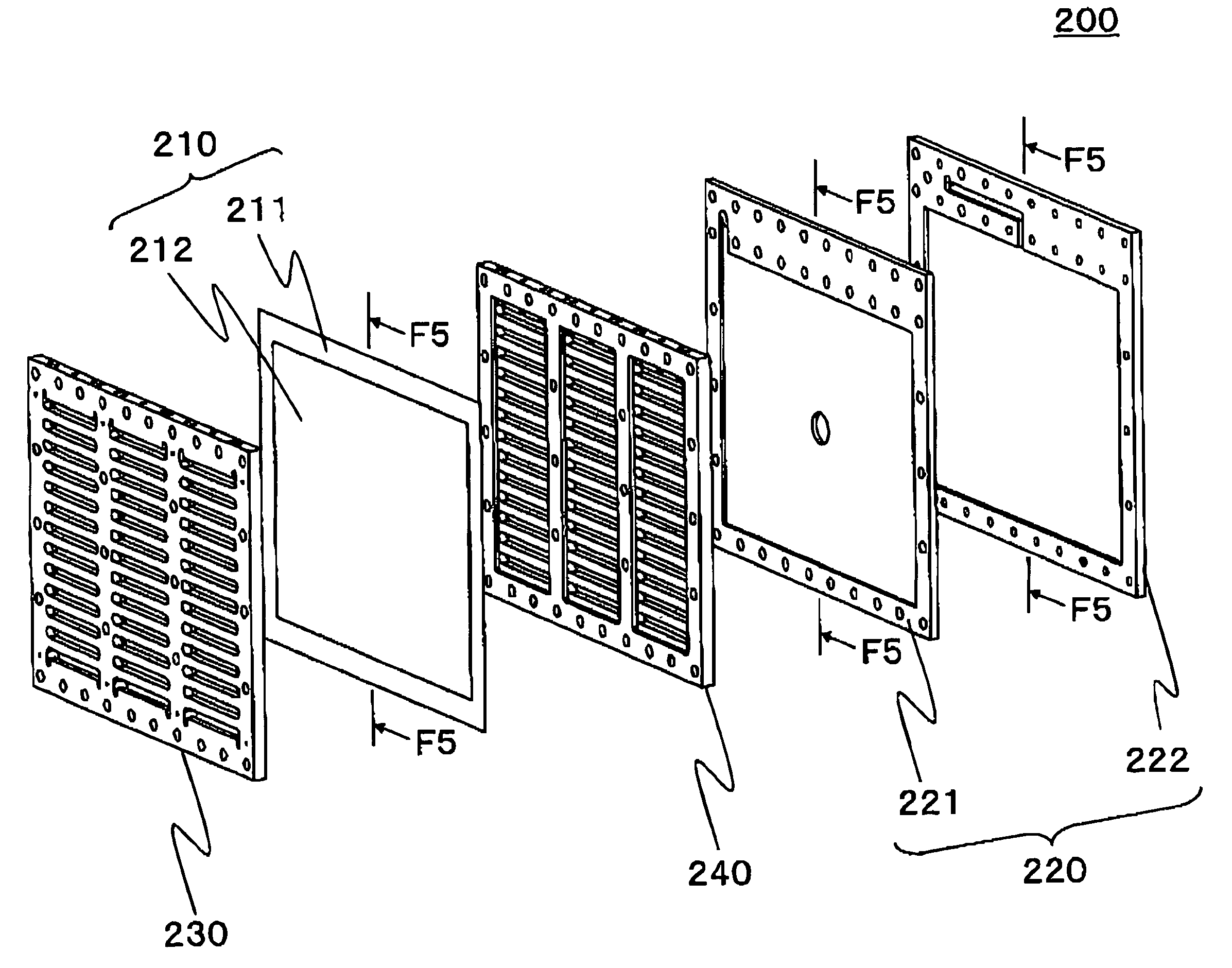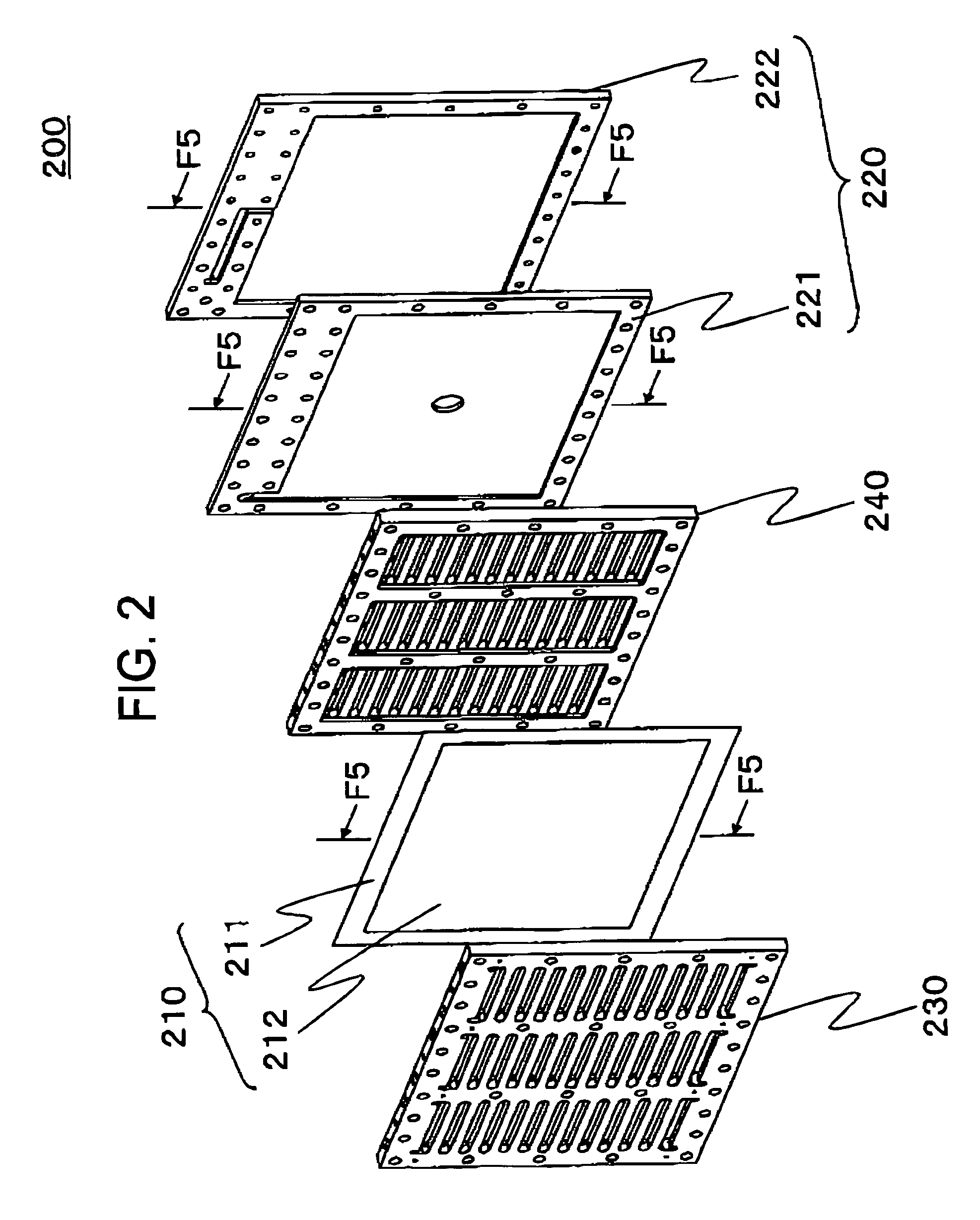Fuel cell exhibiting enhanced hydrogen distribution density
a fuel cell and hydrogen distribution technology, applied in the field of fuel cells, can solve the problems of difficult to increase the overall output voltage of the fuel cell, and achieve the effect of increasing the overall opening area and uniform fuel density distribution on the anode-side catalyst body
- Summary
- Abstract
- Description
- Claims
- Application Information
AI Technical Summary
Benefits of technology
Problems solved by technology
Method used
Image
Examples
embodiment 1
[0045]FIG. 1 shows the structure of a fuel cell system according to the present invention.
[0046]In FIG. 1, a fuel cell system 1 includes a fuel supply portion 100, a fuel cell 200, and a control circuit 300.
[0047]The fuel supply portion 100 may have any structure that can generate hydrogen, and may have a structure in which hydrogen generating substance and hydrogen generation accelerating substance are mixed with each other to discharge hydrogen. Preferably, the fuel supply portion 100 may have a structure in which sodium borohydride as hydrogen generating substance and a malic acid solution as hydrogen generation accelerating substance are mixed with each other to discharge hydrogen.
[0048]As a combination of the hydrogen generating substance and the hydrogen generation-accelerating substance, besides the above-mentioned example, the hydrogen generating substance may be any metal hydrides that can be hydrolyzed and the hydrogen generation accelerating substance may be any hydrogen ...
embodiment 2
[0145]In the fuel inducing portion of the first embodiment, hydrogen is introduced toward the center of the surface of a single anode-side catalyst body. To the contrary, in a second embodiment, hydrogen is induced toward plural locations of the surface of a single anode-side catalyst body. The second embodiment will be described in detail below.
[0146]FIG. 15 is a diagram showing the structure of an anode-side member 221A according to the second embodiment of a fuel cell of the present invention.
[0147]The anode-side member 221A is a modified example of the anode-side member 221 of the fuel cell 200 shown in FIG. 2. The anode-side member 221A includes a recess portion 221-1 on a side where an anode-side catalyst body is disposed. A plurality of through pores 221-4a, 221-4b, and 221-4c are formed in the recess portion 221-1.
[0148]The anode-side member 221A has a triangular surface 221-5 (polygonal surface) formed by the lines passing through the above-mentioned three through pores. In...
modified example 1
[0155]In the second embodiment, the anode-side member 221A includes the triangular surface 221-5 formed by the lines passing through the three through pores. To the contrary, in a first modified example, an anode-side member 221B has a rectangular surface 221-7 formed by the lines passing through four through pores. The first modified example will be described in detail below.
[0156]FIG. 16 is a diagram showing the structure of the anode-side member 221B according to the first modified example of the second embodiment.
[0157]The anode-side member 221B includes through pores 221-6a, 221-6b, 221-6c, and 221-6d.
[0158]In a front view of the anode-side member 221B as viewed from the cathode side, the rectangular surface 221-7 is disposed at a position overlapping the surface of the anode-side catalyst body.
[0159]In this modified example, the above-mentioned four through pores are arranged such that a normal line of the anode-side catalyst body surface passing through the center (the cente...
PUM
| Property | Measurement | Unit |
|---|---|---|
| size | aaaaa | aaaaa |
| depth | aaaaa | aaaaa |
| depth | aaaaa | aaaaa |
Abstract
Description
Claims
Application Information
 Login to View More
Login to View More - R&D
- Intellectual Property
- Life Sciences
- Materials
- Tech Scout
- Unparalleled Data Quality
- Higher Quality Content
- 60% Fewer Hallucinations
Browse by: Latest US Patents, China's latest patents, Technical Efficacy Thesaurus, Application Domain, Technology Topic, Popular Technical Reports.
© 2025 PatSnap. All rights reserved.Legal|Privacy policy|Modern Slavery Act Transparency Statement|Sitemap|About US| Contact US: help@patsnap.com



